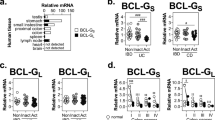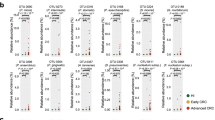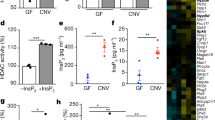Abstract
Butyrate is a key bioactive product of dietary fibre fermentation thought to play a key role in cancer prevention. One contributory mechanism in this role is the regulation of apoptosis by butyrate. As butyrate shows low levels of toxicity, the mechanisms by which it triggers or regulates apoptosis are of great interest. We and others have shown that the proapoptotic protein BAK is upregulated by butyrate. We show here that this observation is conserved across multiple cell lines, that it occurs in all cells in a population and is at the transcriptional level. We have used a promoter-reporter construct to identify the regulatory regions of the BAK promoter and found that much of the transcriptional activity occurs via a single Sp1/Sp3 binding site. We have shown that both Sp1 and Sp3 bind, but upon butyrate treatment Sp1 binding decreases in favour of Sp3 binding. We speculate that this may be an acetylation-mediated event.
This is a preview of subscription content, access via your institution
Access options
Subscribe to this journal
Receive 50 print issues and online access
$259.00 per year
only $5.18 per issue
Buy this article
- Purchase on Springer Link
- Instant access to full article PDF
Prices may be subject to local taxes which are calculated during checkout







Similar content being viewed by others
References
Arasaradnam RP, Riley SA, Corfe BM . (2004). Gut 53: 155–156.
Bingham SA, Day NE, Loben R, Ferrari P, Slimani N, Norat T et al. (2003). Lancet 361: 1496–1501.
Blottiere HM, Buecher B, Galmiche JP, Cherbut C . (2003). Proc Nut Soc 62: 101–106.
Bonithon-Kopp C, Kronborg O, Giacosa A, Rath U, Faivre J . (2000). Lancet 256: 1300–1306.
Bouwman P, Philipsen S . (2002). Mol Cell Endocrinol 195: 27–38.
Braun H, Koop R, Ertmer A, Nacht S, Suske G . (2001). Nucl Acid Res 29: 4994–5000.
Camarero N, Nadal A, Barrero MJ, Haro D, Marrero PF . (2003). Nucl Acid Res 31: 1693–1703.
Chen ZY, Rex S, Tseng CC . (2004). J Nutr 134: 792–798.
Corfe BM, Moir A, Popham D, Setlow P . (1994). Microbiology 140: 3079–3083.
Della Ragione F, Criniti V, Della Pietra V, Borriello A, Oliva A, Indaco S et al. (2001). FEBS Lett 499: 199–204.
Griffiths GJ, Dubrez L, Morgan CP, Jones NA, Whitehouse J, Corfe BM et al. (1999). J Cell Biol 144: 903–914.
Griffiths GJ, Corfe BM, Savory P, Leech S, Esposti MD, Hickman JA et al. (2001). Oncogene 20: 7668–7676.
Hague A, Manning AM, Hanlon AM, Huschtscha LI, Hart D, Paraskeva C . (1993). Int J Cancer 55: 498–505.
Hass R, Busche R, Luciano L, Reale E, vonEngelhardt W . (1997). Gastroenterology 112: 875–881.
Hill MJ . (1997). Eur J Cancer Prev 6: 219–225.
Hill MJ . (2002). Eur J Cancer Prev 11: 1–2.
Hirose T, Sowa Y, Takahashi S, Saito S, Yasuda C, Shindo N et al. (2003). Oncogene 22: 7762–7773.
Le Leu RK, Hu Y, Young GP . (2002). Carcinogenesis 23: 713–719.
Le Leu RK, Brown IL, Hu Y, Young GP . (2003). Carcinogenesis 24: 1347–1352.
MacCarthy-Morrogh L, Wood L, Brimmell M, Johnson PWM, Packham G . (2000). Oncogene 19: 5534–5538.
McIntyre A, Gibson PR, Young GP . (1993). Gut 34: 386–391.
Makin GWJ, Corfe BM, Griffiths GJ, Thistlethwaite A, Hickman JA, Dive C . (2001). EMBO J 20: 6306–6315.
Mariadason JM, Corner GA, Augenlicht LH . (2000). Cancer Res 60: 4561–4572.
Oltvai ZN, Korsmeyer SJ . (1994). Cell 79: 189–192.
Perrin P, Pierre F, Patry Y, Champ M, Berreur M, Pradal G et al. (2001). Gut 48: 53–61.
Potten CS, Wilson JW, Booth C . (1997). Stem Cells 15: 82–93.
Ruemmele FM, Dionne S, Qureshi I, Sarma DSR, Levy E, Seidman EG . (1999). Cell Death Diff 6: 729–735.
Schatzkin A, Lanza E, Corle D, Lance P, Iber F, Caan B et al. (2000). N Engl J Med 342: 1149–1155.
Siavoshian S, Segain JP, Kornprobst M, Bonnet C, Cherbut C, Galmiche JP et al. (2000). Gut 46: 507–514.
Sowa Y, Orita T, Minamikawa-Hiranabe S, Mizuno T, Nomura H, Sakai T . (1999). Cancer Res 59: 4266–4270.
Steiner E, Holzmann K, Pirker C, Elbling L, Micksche M, Berger W . (2004). Biochem Biophys Res Comm 317: 235–243.
Welter C, Antoni H, Blin N . (1991). J Exp Clin Cancer Res 10: 75–80.
Young RL, Korsmeyer SJ . (1993). Mol Cell Biol 13: 3686–3697.
Zhang L, Yu J, Park BH, Kinzler KW, Vogelstein B . (2000). Science 290: 989.
Acknowledgements
We thank Professor C Dive for her support and encouragement throughout this study, Professor B Vogelstein for HCT116 Bax−/−, Mr DWC Chen for technical support and Dr E Williams for a critical reading of the manuscript. This work was funded by BBSRC Grants 34/D16937 and 50/D19346.
Author information
Authors and Affiliations
Corresponding author
Rights and permissions
About this article
Cite this article
Chirakkal, H., Leech, S., Brookes, K. et al. Upregulation of BAK by butyrate in the colon is associated with increased Sp3 binding. Oncogene 25, 7192–7200 (2006). https://doi.org/10.1038/sj.onc.1209702
Received:
Revised:
Accepted:
Published:
Issue Date:
DOI: https://doi.org/10.1038/sj.onc.1209702
Keywords
This article is cited by
-
Homocysteine-induced decrease in HUVEC cells’ resistance to oxidative stress is mediated by Akt-dependent changes in iron metabolism
European Journal of Nutrition (2021)
-
ZBP-89 and Sp1 contribute to Bak expression in hepatocellular carcinoma cells
BMC Cancer (2018)
-
Gut microbiota-mediated inflammation in obesity: a link with gastrointestinal cancer
Nature Reviews Gastroenterology & Hepatology (2018)
-
Is cytotoxicity a determinant of the different in vitro and in vivo effects of bioactives?
BMC Complementary and Alternative Medicine (2017)
-
Diet, microorganisms and their metabolites, and colon cancer
Nature Reviews Gastroenterology & Hepatology (2016)



